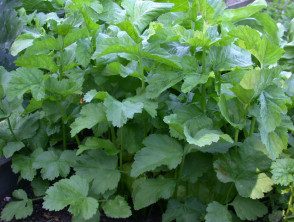| Common name: | Parsnip |
| Botanical name: | Pastinaca sativa |
| Family: | Apiaceae – Carrot family |
| Origin: | Parsnips originated in the Mediterranean, where wild forms were used for food by the early Romans. By the 16th century, parsnips were cultivated in western Europe, particularly the Rhine Valley. |
| Description: | Wild parsnip is a member of the Umbelliferae (parsnip) family. They have a tough, creamy white root, tapering somewhat from the crown, from which arises the erect stem, 30-60 cm high. The leaf-stalks are about 20 cm long, the leaves divided into several pairs of leaflets, each 2-5 cm long, and upto 2cm wide. All the leaflets are finely toothed at their margins and softly hairy, especially on the underside. The flowers are yellow and in umbels at the ends of the stems, similar to the carrot. The flowers of the cultivated Parsnip are a deeper yellow colour than those of the wild plant. |
| Uses: | The food value of Parsnips exceeds that of any other vegetable except potatoes. Wild parsnip is now considered a biennial weed in Europe and America. In Holland, Parsnips are used in soups, whilst in Ireland cottagers make a beer by boiling the roots with water and hops, and afterwards fermenting the liquor. A kind of marmalade preserve has also been made from them, and even wine which in quality has been said to approach the famed Malmsey of Madeira. The fruit is flattened and of elliptical form, strongly furrowed. Parsnip ‘seeds’ as the fruit is commonly called, are pleasantly aromatic, and were formerly collected for their medicinal value and sold by herbalists. They contain an essential oil that has the reputation of curing intermittent fever. A strong decoction of the root is a good diuretic and assists in removing obstructions of the viscera. It has been employed as a remedy for jaundice and gravel. |
| Allergens: | Furocoumarins. Possible role of infection with Sclerotinia sclerotiorum. |
| Allergy: | Wild parsnip can cause phytophotodermatitis. If the plant juices come in contact with skin, in the presence of sunlight, a rash and/or blistering can occur, as well as skin discoloration that may last several months. Phototoxic, urticaria and allergic contact dermatitis have also been reported. In one study, itching and tingling with or without oedema of the lips, mouth and tongue were the most common complaints after eating raw parsnip. In addition, laryngeal and abdominal disturbances, rhinitis and hand dermatitis have been recorded. |
| Cross reactions: | Other umbilliferae |
| Other information: | Part of the parsnip's attraction as a vegetable is its ability to be frozen in the ground, thawed out in the soil, and then later eaten. Since parsnip roots tend to shrivel easily in storage, they are quite often heavily waxed when marketed in retail channels. According to Pliny, Parsnips were held in such repute by the Emperor Tiberius that he had them annually brought to Rome from the banks of the Rhine, where they were then successfully cultivated. They are dressed in various ways and are much eaten with saltfish during Lent. |
| Patch test: | Photo patch test |
